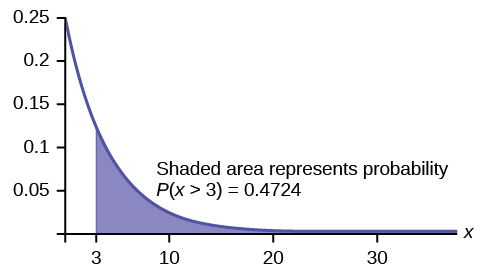Describe a Historical Event Using Exponential Models
In many cases real-world situations can be modeled using linear functions but this is not always true. LnT β0 β1X1 βpXp ε The main difference between AFT models and PH models is that AFT models assumes that effects of covariates are multiplicative on time scale while Cox models use the hazard scale as shown above.

The Exponential Distribution Introductory Business Statistics
The exponential model similar to the spherical model starts from the origin of the coordinates and has a linear behavior near itBut the ascending slope of the curve is less than that of the spherical model.

. Time series forecasting is a technique for the prediction of events through a sequence of time. The simple-exponential growth model is known as the Malthusian growth model. In that case we use this technique which is simply a recursive use of exponential smoothing twice.
The parameter C is the value of the dependent variable y when the independent variable x is zero. Tables A13 and A14 describe results for scenarios S25 to S28 when the historical data follow a Weibull distribution the new data follow a piecewise exponential distribution and data are analysed using either a Bayesian Weibull model Table A13 or a Bayesian piecewise exponential model Table A14. The simplest example of an AFT model is the exponential model which is written as.
The math elements of the exam may take a bit of time to solve and knowing reliability statistics well is a good plan heading into the exam. Where A is the initial population x is the time in years and y is the. Exponential growth is said to follow an exponential law.
Frailty models which are Cox proportional hazard models with mixed effects piecewise exponential PWE survival models with mixed effects and discrete time survival models with mixed effects. Our mission is to provide a free world-class education to anyone anywhere. Which has two parameters.
Data that have a multilevel structure occur frequently across a range of disciplines including epidemiology health services research public health education and sociology. This makes sense because as the smoothing factor approaches 0 we approach the moving average model. Simple exponential models describe situations like this.
Exponential family random graph models ERGMs are a family of statistical models for analyzing data from social and other networks. In Algebra 2 we go deeper and study models that are more elaborate. It is used across many fields of study in various applications including.
Using Exponential Regression to Fit a Model to Data In 2007 a university study was published investigating the crash risk of alcohol impaired driving. The probability plot for 100 normalized random exponential observations 001 is shown below. Event history analysis is a collection of statistical methods for the analysis of longitudinal data on the occurrence and timing of events.
Data from 2871 crashes were used to measure the association of a persons blood alcohol level. Using The Exponential Distribution Reliability Function It may be possible to pass the CRE exam knowing one formula. While exponential smoothing models use weighted averages of past observations to forecast new values Auto-Regressive Integrated Moving Average or ARIMA models look at autocorrelations or serial correlations in the data.
We evaluate model performance to determine changepoint numbers and locations in a simulation study and show the utility of the method using two data sets for time to event data. The models were fitted by using the ets function of the forecast R package. Donate or volunteer today.
We can generate a probability plot of normalized exponential data so that a perfect exponential fit is a diagonal line with slope 1. For example y A2x. An exponential growth model describes what happens when you keep multiplying by the same number over and over again.
3 Statistical Models for Multilevel Survival Analysis. It has many applications particularly in the life sciences and in economics. We can calculate the exponential PDF and CDF at 100 hours for the case where 001.
We describe three families of regression models for the analysis of multilevel. As for exponential smoothing also ARIMA models are among the most widely used approaches for time series forecasting. Modeling using Exponential Functions.
In other words ARIMA models look at differences between values in the time series. Seasonal distribution of storm surge events identified using the exponential basis function above selected threshold and event peaks illustrating a. The variogram of an exponential model never reaches a sill so its range influence is uncertain.
We describe three methods for analysing multilevel survival data. The name is an acronym for AutoRegressive Integrated Moving Average. Double exponential smoothing is used when there is a trend in the time series.
You can learn more about ARIMA models. A simple exponential growth model would be a population that doubled every year. It predicts future events by analyzing the trends of the past on the assumption that future trends will hold similar to historical trends.
Sometimes other functions may fit the data better. These models are described by the family of functions. Khan Academy is a 501c3 nonprofit organization.
1 2 Examples of networks examined using ERGM include knowledge networks 3 organizational networks 4 colleague networks 5 social media networks networks of scientific development 6 and others. As used in sociology event history analysis is very similar to linear or logistic regression analysis except that the dependent variable is a measure of the likelihood or speed of event occurrence. In Algebra 1 students worked with simple exponential models to describe various real-world situations.
In a dataset of Glioblastoma patients we use the piecewise exponential model to describe the general trends in the hazard function.

Fitting Exponential Models To Data Algebra And Trigonometry

The Exponential Distribution Introductory Business Statistics

No comments for "Describe a Historical Event Using Exponential Models"
Post a Comment